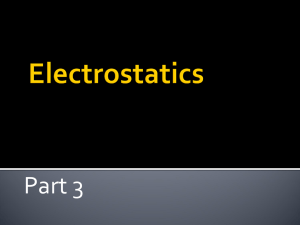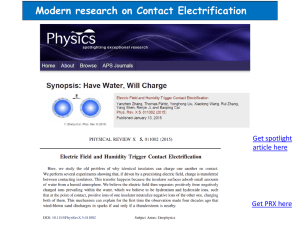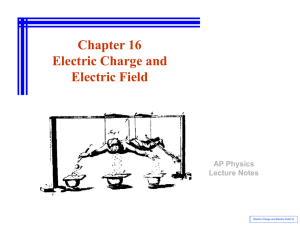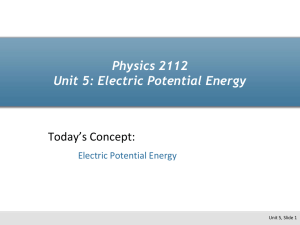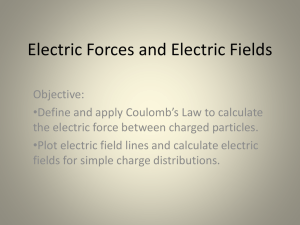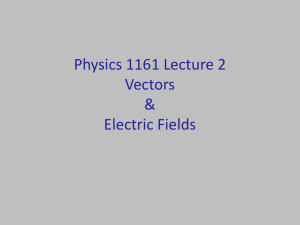Coulomb`s Law
advertisement
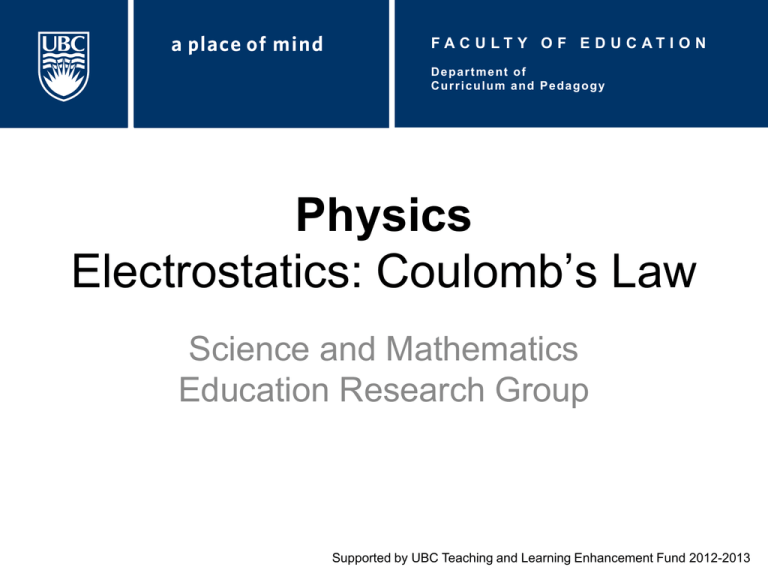
FA C U LT Y O F E D U C AT I O N Department of Curriculum and Pedagogy Physics Electrostatics: Coulomb’s Law Science and Mathematics Education Research Group Supported by UBC Teaching and Learning Enhancement Fund 2012-2013 Coulomb’s Law Fe k q1 q2 r – 2 + r Coulomb’s Law I Consider two opposite charges, q1 and q2 a distance r apart. According to Coulomb’s law, the magnitude of the force between the two charges is: Fe k q1 q2 r2 If q1 is doubled, the magnitude of the force will: A. Decrease by a factor of 4 – B. Decrease by a factor of 2 C. Remain the same D. Increase by a factor of 2 E. Increase by a factor of 4 + r Solution Answer: D Justification: The electric force one charge exerts on another is directly proportional to the product of the two charges, and thus is also proportional to each individual charge. If the magnitude of one charge is doubled then the magnitude of the force is also doubled. The force is not proportional to the square of the charge, so the magnitude of the force will not change by a factor of four. F1 k F2 k q1 q2 r2 2q1 q2 r 2 2k q1 q2 r 2 2 F1 Coulomb’s Law II Consider two opposite charges, q1 and q2 a distance r apart. According to Coulomb’s law, the magnitude of the force between the two charges is: Fe k q1 q2 r2 If r is doubled, the magnitude of the force will: A. Decrease by a factor of 4 – B. Decrease by a factor of 2 C. Remain the same D. Increase by a factor of 2 E. Increase by a factor of 4 + r Solution Answer: A Justification: The electric force is proportional to the inverse square of the distance between the charges. If the distance between the charges double, the magnitude of the force decreases by a factor of 4. As the distance increases, the square increases. Dividing by a larger number gives a smaller answer. Similarly, if the distance decreases, the square decreases. Dividing by a smaller answer gives a larger answer. F1 k F2 k q1 q2 r2 q1 q2 ( 2r ) 2 k q1 q2 4r 2 1 F1 4 Coulomb’s Law III Consider two opposite charges, q1 and q2 a distance r apart. According to Coulomb’s law, the magnitude of the force between the two charges is: Fe k q1 q2 r2 If q1, q2, and r are all doubled, the magnitude of the force will: A. Decrease by a factor of 4 – B. Decrease by a factor of 2 C. Remain the same D. Increase by a factor of 2 E. Increase by a factor of 4 + r Solution Answer: C Justification: Doubling one charge increases the force by a factor of 2, so doubling both charges increases the force by a factor of 4. Doubling distance decreases the force by a factor of 4. The increase caused by the doubled charge is negated by the decrease caused by the doubled distance. F1 k F2 k q1 q2 r2 2q1 2q2 ( 2r ) 2 4k q1 q2 4r 2 F1 Coulomb’s Law IV Consider two uniformly charged spheres a small distance apart. Sphere 1 has a +3q charge while sphere 2 has a -q charge. Which of the following diagrams correctly shows the magnitude and direction of the electrostatic forces? A. 1 2 F1 on 2 3q B. -q 1 2 F1 on 2 F2 on 1 -q F2 on 1 1 3q F1 on 2 3q F2 on 1 C. 2 D. -q F2 on 1 1 2 3q -q F1 on 2 Solution Answer: C Justification: Opposite charges attract, like charges repel. This discounts D, where the charges push each other apart. Newton’s Third Law states that for every action there must be an equal and opposite reaction. This means that the force that charge 1 exerts on charge 2 has the same magnitude as the force that charge 2 exerts on charge 1, but acts in the opposite direction. Alternatively, the equation for Coulomb’s Law does not change when we consider the force of charge 1 on charge 2 or vice versa. 1 2 F1 on 2 3q F2 on 1 -q Coulomb’s Law V Three charges with equal magnitudes are arranged horizontally and spaced evenly apart as shown: Q1 Q2 Q3 +q +q -q Which of the following free-body diagrams best represents the electric forces acting on Q3? A. F1 on 3 B. F2 on 3 D. F1 on 3 C. F2 on 3 F1 on 3 F2 on 3 E. F1 on 3 F2 on 3 F1 on 3 F2 on 3 Solution Answer: E Justification: Both Q1 and Q2 are positive, while Q3 is negative. Opposite charges attract, so Q3 is attracted to the other two charges and experiences a net force to the left. Both Q1 and Q2 have the same charge, q, so the magnitude of the forces they each exert on Q3 will depend on the distance of each charge from Q3. The distance between Q1 and Q3 is twice the distance between Q2 and Q3. The force one charge exerts on another is inversely proportional to the square of the distance between the two charges. Q1 is twice as far as Q2 from Q3, and therefore, F1 on 3 must be four times smaller than F2 on 3. F1 on 3 F2 on 3 Coulomb’s Law VI Three charges with equal magnitudes are arranged horizontally and spaced evenly apart as shown: Q1 Q2 Q3 +q +q -q Which of the following free-body diagrams best represents the electric forces acting on Q1? A. B. F2 on 1 F3 on 1 F3 on 1 D. F 2 on 1 E. F3 on 1 C. F2 on 1 F 2 on 1 F3 on 1 F2 on 1 F3 on 1 Solution Answer: A Justification: Charges Q2 and Q1 have the same sign, so they repel each other. Q2 is pushing Q1 away. Q1 and Q3 are of opposite sign, and will attract each other. Q3 is pulling Q1 closer . The distance between Q1 and Q3 is twice the distance between Q2 and Q3. The force is proportional to the inverse of the distance, so F3 on 1 must be smaller than F2 on 1 by a factor of 4. A. F2 on 1 F3 on 1
